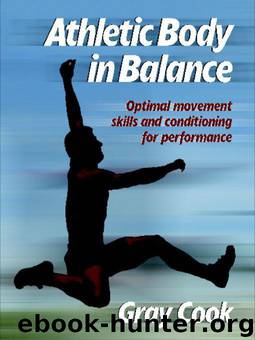Athletic Body in Balance by Cook Gray

Author:Cook, Gray [Cook, Gray]
Language: eng
Format: epub
Publisher: Human Kinetics - A
Published: 2003-05-05T05:00:00+00:00
Figure 10.1 Tall kneeling dumbbell curl and press: (a) while kneeling, grab a dumbbell with each hand; (b) press the dumbbells overhead.
DEEP SQUAT DUMBBELL PUSH-PRESS
Stand with feet shoulder-width apart, a dumbbell in each hand. Pull in the abdominals, keeping them relaxed. Breathe. Hold the dumbbells in front of the shoulders so that palms are turned toward each other. If you prefer a more open position, turn palms forward and pull shoulders back.
Descend into a deep squat (figure 10.2a). If this is uncomfortable, you have poor form, or the heels come up, use a slight heel lift. Try a 1-inch heel lift first; if that isn’t enough, go to a 1 1/2-inch heel lift. If you feel you need more than a 1 1/2-inch heel lift, return to the mobility and stability routine for the squat and work on improving movement patterns.
Once in a deep squat, check body posture. Make sure the abs are still pulled in. Relax until you feel a stretch in the buttocks or groin. Come out of the squat and return to the start position, then press the dumbbells overhead (figure 10.2b). This is a push-press movement, so use the legs. Bend knees slightly and push through the legs. Lift the dumbbells off the shoulders and overhead. Hold the position, arms slightly wider apart than feet, palms turned toward each other or turned forward. Do not hyperextend the elbows. Lower the dumbbells very slowly while maintaining posture and repeat the entire movement.
The deep squat dumbbell push-press can be very fatiguing because it involves full range of motion of both arms and legs. Remember that work is the result of force times distance. Reducing the force but proportionally increasing the distance results in the same amount of work. If you feel like the weights are too light, consider the distance that weight is being moved. It is not about the weight; it is about strength.
Do not hyperextend the knees, and use the legs as much as needed to propel the dumbbells off the shoulders. As the arms fatigue, you will have to use more leg. This is an important connection for your brain to learn as the body transmits power from the legs, through the torso, and into the shoulders. Performing this exercise will increase efficiency in transmitting power from a double-leg stance.
Use a weight you can handle for 6 to 10 repetitions. If you cannot achieve 6 repetitions without losing balance or form or becoming overly fatigued, you have too much weight. If you can exceed 10 repetitions with ease while keeping proper technique and maintaining proper posture, the weight is too light. Perform 1 to 3 sets, depending on weightlifting experience and conditioning level.
Download
This site does not store any files on its server. We only index and link to content provided by other sites. Please contact the content providers to delete copyright contents if any and email us, we'll remove relevant links or contents immediately.
Periodization Training for Sports by Tudor Bompa(8217)
Bodyweight Strength Training by Jay Cardiello(7879)
Born to Run: by Christopher McDougall(7092)
Inner Engineering: A Yogi's Guide to Joy by Sadhguru(6757)
Asking the Right Questions: A Guide to Critical Thinking by M. Neil Browne & Stuart M. Keeley(5712)
The Fat Loss Plan by Joe Wicks(4879)
Bodyweight Strength Training Anatomy by Bret Contreras(4647)
Yoga Anatomy by Kaminoff Leslie(4336)
Dynamic Alignment Through Imagery by Eric Franklin(4179)
Science and Development of Muscle Hypertrophy by Brad Schoenfeld(4105)
Exercise Technique Manual for Resistance Training by National Strength & Conditioning Association(4024)
ACSM's Complete Guide to Fitness & Health by ACSM(4023)
The Four-Pack Revolution by Chael Sonnen & Ryan Parsons(3947)
Bodyweight Strength Training: 12 Weeks to Build Muscle and Burn Fat by Jay Cardiello(3942)
The Ultimate Bodybuilding Cookbook by Kendall Lou Schmidt(3909)
Yoga Anatomy by Leslie Kaminoff & Amy Matthews(3883)
American Kingpin by Nick Bilton(3822)
Nutrition for Sport, Exercise, and Health by Spano Marie & Kruskall Laura & Thomas D. Travis(3745)
Yoga Therapy by Mark Stephens(3723)
